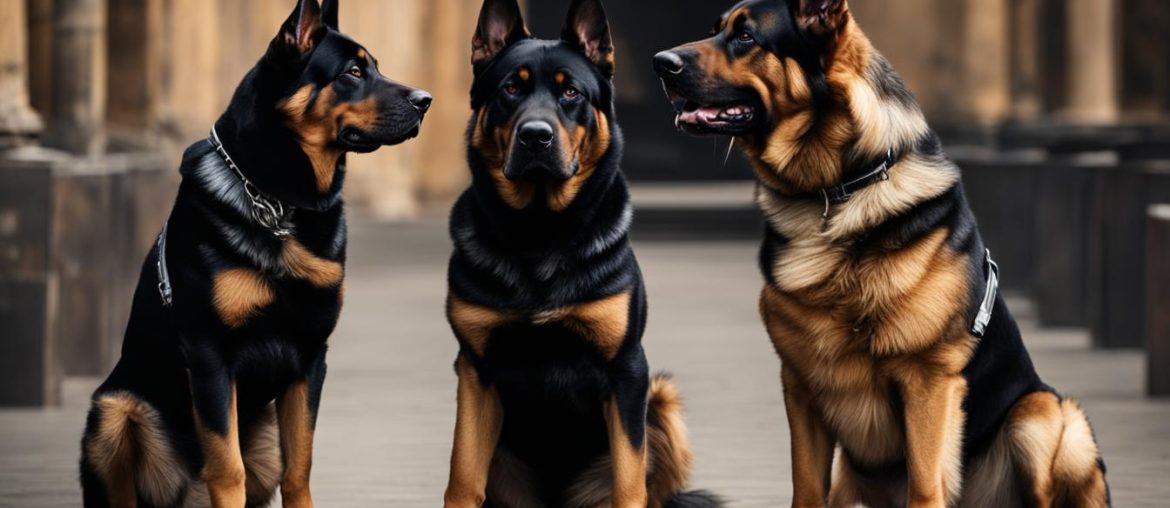When it comes to choosing the perfect canine companion, the decision can often be overwhelming. With so many breeds to consider, I would advise that you research and understand the key differences between them. In this comprehensive breed comparison, I will delve into the contrasting characteristics of two beloved breeds: the Rottweiler and the German Shepherd. By exploring their temperament, physical traits, exercise needs, and training requirements, I aim to provide you with valuable insights to help you make an informed decision.
Key Takeaways
- Both the Rottweiler and German Shepherd possess distinct temperaments, with Rottweilers being loyal, loving, and confident guardians, while German Shepherds are confident, courageous, and intelligent.
- Rottweilers have a stockier, muscular build, while German Shepherds are leaner and more agile.
- Both breeds excel as guard dogs due to their natural protective instincts.
- Rottweilers require at least one hour of exercise per day, while German Shepherds need a minimum of two hours to meet their physical and mental stimulation needs.
- Training both breeds requires expertise, but German Shepherds generally prove to be more easily trainable.
Rottweiler vs. German Shepherd – Temperament Differences
When it comes to comparing the temperament of Rottweilers and German Shepherds, you should understand the unique traits and characteristics of each breed. Both breeds exhibit qualities that make them excellent companions, but there are distinct differences in their temperaments.
Rottweilers are known for their loyalty and love for their families. They are confident guardians who are always ready to protect their loved ones. With their strong instincts and courageous nature, they make excellent watchdogs. Rottweilers are also known to be assertive and dominant, which requires firm and consistent training to bring out their best qualities. Due to their protective nature, you should socialize them properly from an early age to ensure they are comfortable around strangers and other animals.
German Shepherds, on the other hand, are highly intelligent and versatile dogs. They are confident and courageous, making them excellent working dogs in various fields such as search and rescue, police work, and service dogs. German Shepherds possess a strong desire to please their owners, making them highly trainable. Their adaptability and intelligence allow them to quickly learn new commands and tasks. With proper training and socialization, German Shepherds are generally friendly and good with children and other pets.
“Rottweilers are loyal, loving, and confident guardians, while German Shepherds are confident, courageous, and intelligent.”
| Temperament Characteristics | Rottweiler | German Shepherd |
|---|---|---|
| Loyalty | Loyal and devoted to their families | Loyal with a strong desire to please |
| Protective Instincts | Strong protective instincts, can be dominant | Protective but more adaptable |
| Socialization | Requires early socialization to be comfortable around strangers | Generally friendly with proper socialization |
Overall, both Rottweilers and German Shepherds are intelligent, confident, and loyal dogs. However, Rottweilers may require experienced handling and consistent training due to their dominant nature, while German Shepherds are generally more adaptable and easier to train. You should consider your lifestyle and experience when choosing between these two breeds, as their distinct temperaments will require different levels of attention and commitment.
Rottweiler vs. German Shepherd – Physical Characteristics
When comparing the physical characteristics of Rottweilers and German Shepherds, there are distinct differences that set these two breeds apart. Rottweilers are known for their impressive size and muscular build. They typically stand between 22 and 27 inches tall at the shoulder and weigh anywhere from 80 to 135 pounds. With a broad chest, powerful limbs, and a square-shaped frame, Rottweilers exude strength and agility. Their physical presence alone can be quite imposing.
On the other hand, German Shepherds have a more lean and athletic appearance. They typically stand between 22 and 26 inches tall at the shoulder and weigh between 50 to 90 pounds. German Shepherds have a longer body, a deep chest, and a graceful stride. This breed’s physical structure is built for endurance and speed, allowing them to excel in various activities such as herding, agility, and obedience competitions.
Both breeds have different physical characteristics that make them unique. Rottweilers possess a robust and stocky build, while German Shepherds showcase a more streamlined and agile physique.
| Rottweiler | German Shepherd | |
|---|---|---|
| Height | 22-27 inches | 22-26 inches |
| Weight | 80-135 pounds | 50-90 pounds |
| Physical Build | Muscular and square-shaped | Lean and athletic |
| Agility | Less agile | More agile |
“Rottweilers possess a robust and stocky build, while German Shepherds showcase a more streamlined and agile physique.”
As seen in the table and described above, the physical characteristics of Rottweilers and German Shepherds provide insight into their appearances and unique strengths. These differences contribute to the overall temperament, agility, and suitability of each breed for different lifestyles and purposes.
Rottweiler vs. German Shepherd – Best Guard Dog
When it comes to choosing a breed for protection and guarding, both the Rottweiler and German Shepherd are top contenders. With their territorial nature and strong protective instincts, they are often sought after as reliable and effective guard dogs.
The Rottweiler, known for its intimidating presence, is a natural choice for a guard dog. With a history rooted in herding and guarding livestock, Rottweilers are inherently protective of their family and property. They have a natural instinct to assess potential threats and act accordingly, making them an excellent choice for deterring intruders.
The German Shepherd, on the other hand, combines intelligence, loyalty, and courage, making it another formidable guard dog. Bred originally as herding dogs, German Shepherds have a strong sense of loyalty and are fiercely protective of their owners. They are known to quickly assess situations and respond appropriately, making them effective in guarding homes and properties.
Both breeds require proper training and socialization from an early age to ensure that their guarding instincts are channeled correctly. With consistent training and positive reinforcement, they can become reliable and disciplined guard dogs. However, it should be noted that their protective nature may lead to them being more reserved or cautious around strangers, requiring careful management in social situations.
| Rottweiler | German Shepherd | |
|---|---|---|
| Temperament | Protective, Loyal, Dominant | Loyal, Courageous, Intelligent |
| Size | 80-135 pounds | 50-90 pounds |
| Exercise Needs | At least 1 hour per day | At least 2 hours per day |
| Trainability | Stubborn, Requires Firm Training | Easier to Train, Excels in Obedience |
In conclusion, both the Rottweiler and German Shepherd excel as guard dogs due to their territorial and protective instincts. While the Rottweiler’s size and dominant nature may make it appear more intimidating, the German Shepherd’s loyalty and intelligence also make it a formidable choice. Ultimately, the decision between these two breeds as a guard dog comes down to personal preference, training capabilities, and the specific needs of your home and family.
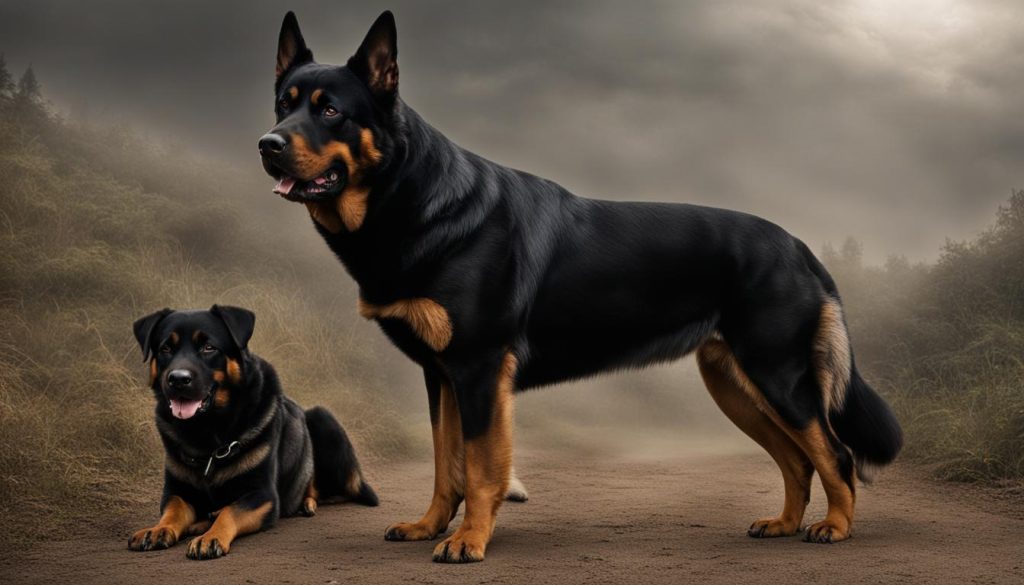
Rottweiler vs. German Shepherd – Exercise Needs
When it comes to exercise needs, both Rottweilers and German Shepherds are active breeds that require regular physical activity and mental stimulation to thrive. I would recommend to provide them with the right amount of exercise to keep them happy, healthy, and well-behaved.
Rottweilers need at least one hour of exercise per day to burn off their energy and stay mentally engaged. This exercise can include activities like brisk walks, jogging, playing fetch, or participating in dog sports such as agility or obedience training. Rottweilers are muscular and powerful dogs, so you should provide them with activities that promote their physical strength and endurance.
German Shepherds, on the other hand, have even higher exercise needs and require at least two hours of daily physical activity. They are highly intelligent and energetic dogs that thrive on mental stimulation. In addition to regular exercise routines, German Shepherds benefit from engaging in challenging activities like puzzle toys, scent work, or advanced training sessions.
Rottweiler vs. German Shepherd – Exercise Comparison
| Rottweiler | German Shepherd | |
|---|---|---|
| Exercise Needs | At least 1 hour per day | At least 2 hours per day |
| Physical Activity | Brisk walks, jogging, playing fetch, dog sports | Brisk walks, jogging, playing fetch, dog sports, puzzle toys, scent work, advanced training |
| Mental Stimulation | Required | Highly required |
Rottweilers and German Shepherds are active breeds that require regular exercise to maintain their physical and mental well-being. You should provide them with activities that challenge their intelligence and physical abilities. Neglecting their exercise needs can lead to behavioral issues, such as excessive barking, destructive chewing, or aggression. With proper exercise and mental stimulation, both Rottweilers and German Shepherds can be happy and content companions.
To put it simply, the exercise needs of individual dogs may vary based on age, health, and overall fitness level. It is always recommended to consult with a veterinarian or professional dog trainer to develop a tailored exercise plan for your Rottweiler or German Shepherd based on their specific needs and abilities.
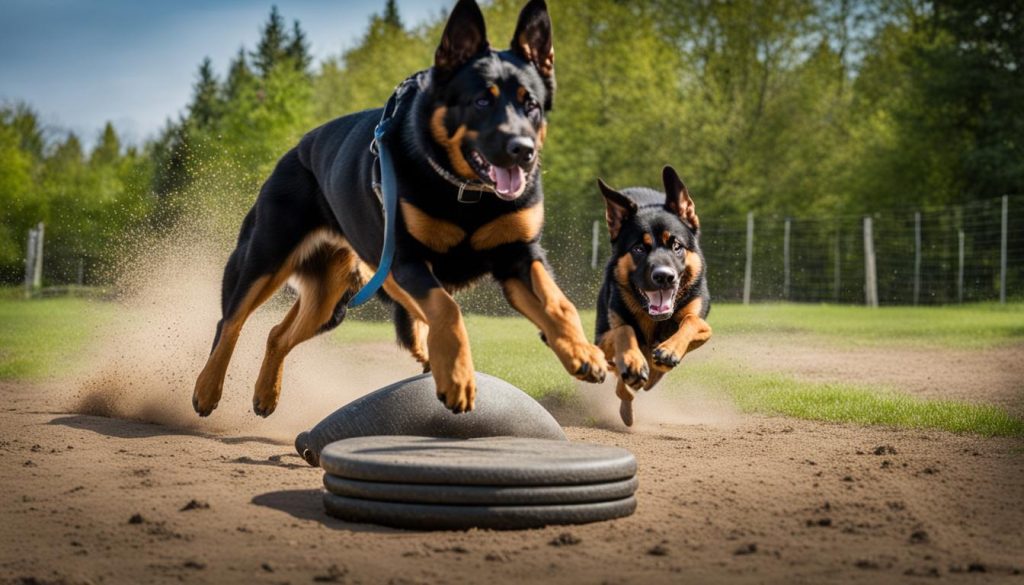
Rottweiler vs. German Shepherd – Training Requirements
Training is an essential aspect of owning a dog, and both Rottweilers and German Shepherds are intelligent and trainable breeds. However, there are certain differences in their training requirements. Rottweilers, known for their stubbornness and dominance, may require a firm and experienced trainer to establish control. Consistency and positive reinforcement methods are key when training a Rottweiler. You might want to establish yourself as the pack leader early on to prevent any behavioral issues.
On the other hand, German Shepherds are generally easier to train and have a strong desire to please their owners. They respond well to positive reinforcement, consistency, and praise. German Shepherds excel in obedience training and can quickly grasp commands and tasks. Their intelligence and willingness to learn make them popular choices for various working roles, such as police and military dogs.
both breeds require early socialization to ensure they become well-rounded and well-behaved adults. Providing ample mental stimulation through interactive toys and training exercises is also crucial to prevent boredom and destructive behaviors.
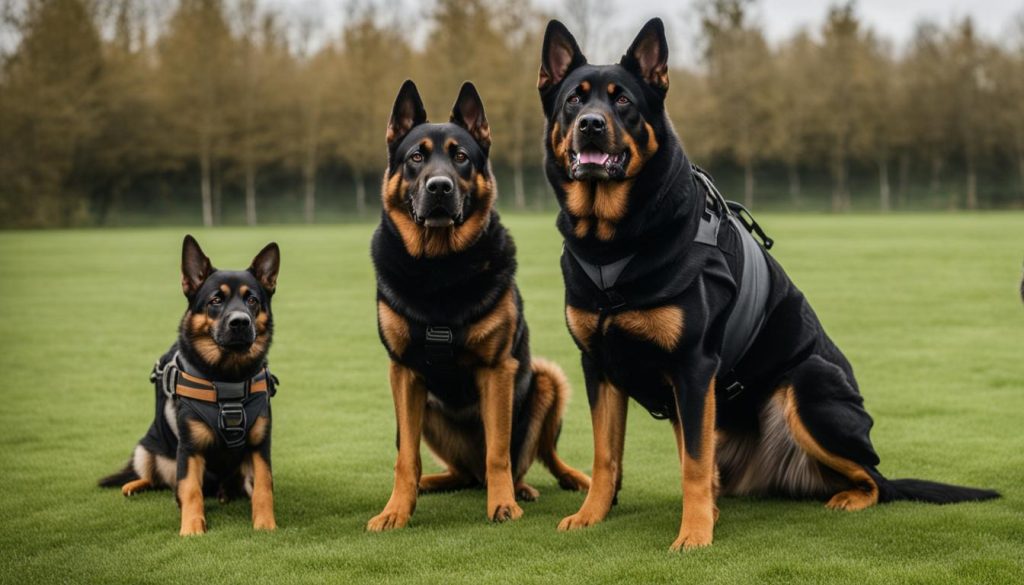
Rottweiler vs. German Shepherd – Choosing the Right Family Pet
When considering the Rottweiler vs. German Shepherd as a family pet, carefully evaluate their temperament, compatibility, and socialization needs.
Both breeds can be excellent choices for families, but please understand their unique characteristics and requirements. Rottweilers and German Shepherds are generally known for their loyalty, but their temperaments differ slightly.
A well-socialized and trained Rottweiler can be a loving and protective family pet, while a German Shepherd is often praised for its adaptability and eagerness to please.
To ensure a harmonious relationship with these breeds, I would advise that you provide proper socialization from an early age and ongoing training. Both breeds can be good with children, but supervision and teaching children how to interact with dogs respectfully is important.

Table: Temperament and Compatibility
| Breed | Temperament | Compatibility with Family and Children |
|---|---|---|
| Rottweiler | Loyal, loving, confident guardian | Good with proper socialization and training |
| German Shepherd | Confident, courageous, intelligent | Good with proper socialization and training |
Both the Rottweiler and German Shepherd can be wonderful family pets when given the right environment and training. I recommend that you invest time and effort into their socialization and obedience training to ensure a happy and harmonious relationship with your family.
By understanding the temperament, compatibility, and socialization requirements of both breeds, you can make an informed decision when choosing the right family pet between the Rottweiler and German Shepherd.
Rottweiler vs. German Shepherd – Breed Information
Understanding the breed information of Rottweilers and German Shepherds can provide valuable insights into their history, origin, and working dog capabilities. Both breeds have distinct characteristics that make them unique and sought after by dog enthusiasts.
Rottweiler
The Rottweiler, also known as the Rottie, has a rich history as a working dog. Originating in Rottweil, Germany, they were originally bred to herd and guard livestock. With their strength, endurance, and intelligence, Rottweilers excelled in their role as herders and protectors. Today, they are often utilized in various working capacities, such as search and rescue, police work, and therapy dogs.
German Shepherd
The German Shepherd, or GSD, has a similar working background as the Rottweiler. Developed in Germany during the late 19th century, they were initially bred for herding sheep. However, their exceptional traits, including their intelligence, trainability, and versatility, led to their extensive use as police and military dogs. German Shepherds are renowned for their ability to perform tasks such as tracking, scent detection, and protection work.
Working Dogs
Both Rottweilers and German Shepherds have excelled as working dogs due to their natural instincts, physical capabilities, and intelligence. They possess a strong work ethic, loyalty, and dedication to their tasks, making them valuable assets in various fields. Their history as working dogs contributes to their trainability and adaptability, as they have been selectively bred for specific working traits over generations.
| Breed | Origin | Historical Use |
|---|---|---|
| Rottweiler | Rottweil, Germany | Herding and guarding livestock |
| German Shepherd | Germany | Herding sheep and later police/military work |
Both Rottweilers and German Shepherds possess a proud heritage as working dogs, and their breed information showcases their pretty good abilities and contributions. Understanding their origins and historical use can provide valuable context when considering these breeds as pets or working companions.

Rottweiler vs. German Shepherd – Health and Lifespan
When comparing the health and lifespan of Rottweilers and German Shepherds, it is essential to consider common genetic diseases that affect both breeds. One significant health issue both breeds are susceptible to is hip dysplasia. Hip dysplasia occurs when the hip joint does not develop correctly, leading to discomfort, pain, and, in severe cases, mobility issues. Regular veterinary check-ups and early detection can help manage and mitigate the effects of this condition.
Rottweilers typically have a shorter lifespan compared to German Shepherds. On average, Rottweilers live around 9 to 10 years, while German Shepherds have a slightly longer lifespan, averaging 9 to 12 years. However, individual lifespan can vary based on factors such as genetics, overall health, and lifestyle.

| Breed | Lifespan | Common Health Issues |
|---|---|---|
| Rottweiler | 9 to 10 years | Hip dysplasia, elbow dysplasia, heart conditions, bloat |
| German Shepherd | 9 to 12 years | Hip dysplasia, elbow dysplasia, degenerative myelopathy, bloat |
While both breeds can face similar health challenges, responsible breeding practices and proactive care can help minimize the risk of these conditions. Additionally, providing a healthy diet, regular exercise, and mental stimulation can contribute to overall well-being and longevity in both Rottweilers and German Shepherds.
Rottweiler vs. German Shepherd – Popularity and Loyalty
German Shepherds are undeniably more popular than Rottweilers, consistently ranking higher on the list of popular dog breeds. Their intelligence, versatility, and loyalty have made them a favorite among dog owners. German Shepherds are often chosen for their ability to excel in various roles, including search and rescue, police work, and as service dogs. Their admirable qualities have captured the hearts of many, making them a popular choice among families and individuals seeking a loyal and trustworthy companion.
Rottweilers, although not as prevalent as German Shepherds, still hold a significant fan base. Known for their unwavering loyalty to their owners, Rottweilers are deeply devoted and protective. They have a strong bond with their families and will go to great lengths to ensure their safety. While they may not be as widely recognized as German Shepherds, Rottweilers have a dedicated following of enthusiasts who appreciate their loving nature and fierce devotion.
When it comes to popularity, personal preferences and individual lifestyles play a significant role. While some may gravitate towards the popularity of the German Shepherd, others may be drawn to the unique qualities of the Rottweiler. It ultimately boils down to what traits and characteristics resonate most with the potential dog owner.
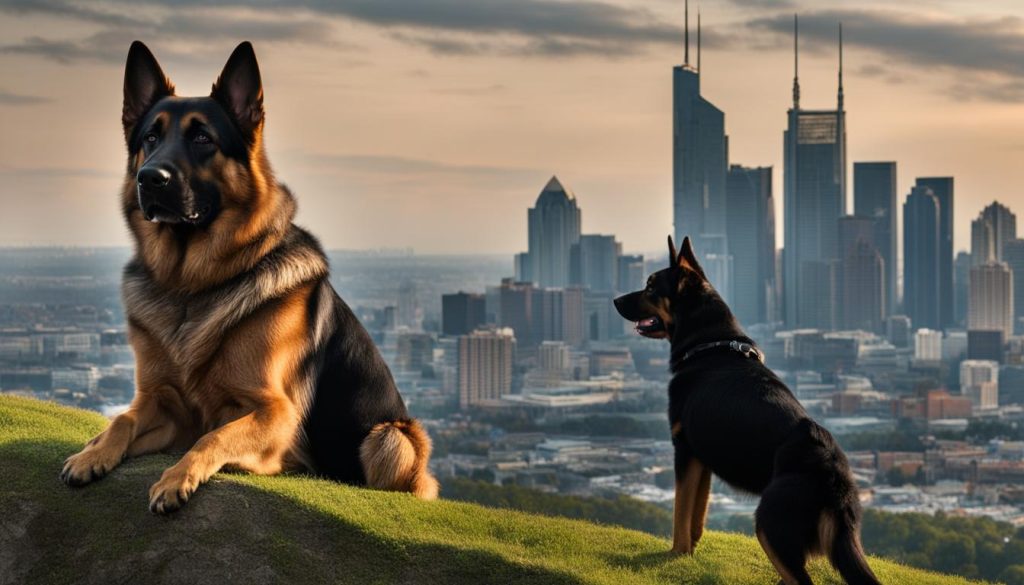
Loyal Companions
Both the Rottweiler and German Shepherd have a reputation for being loyal companions. They form deep bonds with their owners and are known for their unwavering dedication. Whether it’s providing comfort during difficult times or offering protection, these breeds are committed to their human counterparts. Their loyalty extends beyond the home, as they are also known to be fiercely protective of their families and territories.
loyalty should not be taken for granted. Building a strong bond with any dog requires time, effort, and consistent training. Socialization from an early age, along with positive reinforcement methods, can help foster a healthy and trusting relationship between dogs and their owners. When properly cared for and nurtured, both Rottweilers and German Shepherds can prove to be lifelong loyal companions.
| Breed | Popularity Ranking | Loyalty to Owner |
|---|---|---|
| German Shepherd | 2 | High |
| Rottweiler | 8 | High |
Table: Popularity Ranking and Loyalty to Owner
In summary, German Shepherds are more popular than Rottweilers, but popularity alone should not be the sole criteria for choosing a dog. Both breeds offer unwavering loyalty to their owners and can make excellent companions when given the proper care, training, and socialization. Ultimately, the decision between these two pretty good breeds should be based on individual lifestyle, requirements, and preference.
Final Thoughts
In this comprehensive breed comparison between the Rottweiler and German Shepherd, we have explored their temperament, physical characteristics, exercise needs, training requirements, and more. By considering these factors, you can make an informed decision when choosing the right dog breed for you and your family.
The Rottweiler is known for its loyalty, love, and confidence as a guardian. With their protective nature, they can be a great choice for those seeking a devoted and brave companion. On the other hand, the German Shepherd is known for its adaptability, intelligence, and eagerness to please. They excel in various roles, including guarding, police work, and as family pets.
When it comes to physical characteristics, the Rottweiler is stockier and larger, while the German Shepherd is leaner and more agile. Both breeds require regular exercise to keep them happy and healthy, but the German Shepherd has a higher exercise need, demanding at least two hours of daily activity. Their high intelligence makes both breeds trainable, but Rottweilers may require a more experienced trainer due to their stubbornness and dominance.
Ultimately, choosing the right dog breed depends on your lifestyle, experience, and preference. Whether you decide on a Rottweiler or German Shepherd, both breeds have unique qualities that can make them wonderful companions. Try to provide them with proper training, socialization, and care to ensure a happy and fulfilling relationship with your furry friend.
FAQ
What are the differences in temperament between Rottweilers and German Shepherds?
Rottweilers are known to be loyal, loving, and confident guardians, while German Shepherds are confident, courageous, and intelligent.
What are the physical characteristics of Rottweilers and German Shepherds?
Rottweilers are stockier and larger, with a more muscular build, while German Shepherds are more agile and have a leaner body.
Are Rottweilers and German Shepherds good guard dogs?
Yes, both breeds have strong guarding instincts and are territorial and protective of their families and property.
How much exercise do Rottweilers and German Shepherds need?
Rottweilers require at least one hour of exercise per day, while German Shepherds need at least two hours of daily exercise.
Are Rottweilers and German Shepherds easy to train?
Both breeds are highly intelligent and trainable, but Rottweilers can be more stubborn and dominant, requiring a firm and experienced trainer.
Are Rottweilers and German Shepherds good family pets?
With proper socialization and training, both breeds can be good family pets. They are generally good with children, but supervision is necessary.
What is the historical background of Rottweilers and German Shepherds?
Rottweilers have a history as working dogs, used for herding and guarding livestock, while German Shepherds were originally bred as herding dogs but have also excelled as police and military dogs.
What are the common health issues and lifespans of Rottweilers and German Shepherds?
Both breeds are susceptible to certain health issues, including hip dysplasia. Rottweilers generally have a shorter lifespan of around 9 to 10 years, while German Shepherds live slightly longer, averaging 9 to 12 years.
Are Rottweilers or German Shepherds more popular?
German Shepherds are more popular than Rottweilers, but both breeds are known for their loyalty to their owners.
How do I choose between a Rottweiler and a German Shepherd?
Choosing the right dog breed depends on your lifestyle, experience, and preference. Consider their temperament, physical characteristics, exercise needs, and training requirements before making a decision.


